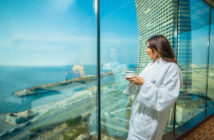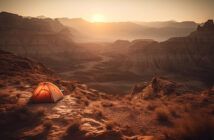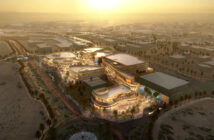“Everything is in Riyadh”
Ten minutes to touchdown and all you see from your window seat is a vast, sandy escarpment. “Where is this city of eight million people?” you wonder. A few traces of humanity come into view, then a wave of metropolitan homes, shops, and skyscrapers floods your view. “Impressive!”
Riyadh’s treasures seem to gradually unfold, increasing in allure and diversity the longer you stay. From historic Al Masmak Fortress to Diriyah’s JAX art district to King Abdullah Financial District’s state-of-the-art architecture, Riyadh offers something for everyone if you’re curious and patient enough to enjoy the adventure.
From the country’s humble origins in a mud-brick fortress to today’s world-leading giga projects, the rate of change and resulting social adaptation in Riyadh has been stunning. While modern-day Riyadh is bustling with malls, busy streets, and lively plazas at night, life was quite different in the mid-1990s. “All shops in my neighborhood would shut after evening’s Isha prayer. To pick up khubz (bread) at night, I used to drop money in a box outside the bake shop and get a piece from a basket beside it,” recollects Hussam Alrwais, Client Progress Coordinator at Arabius. “Local residents back in the day also slept as early as 9pm,” he adds, highlighting the contrast to today’s events starting at that time!
“There are so many cool cafes in Riyadh, everyone can have one to themselves!” jokes Malak AlMasoud, a talented artist and Graphic Designer leading the Arabius app design team. “My idea of a perfect weekend is dining at a well-reviewed restaurant, café-hopping with my sisters, then just walking the streets into the night. That’s how we chill,” she laughs.
Growing up in Al Kharj, an hour’s drive from Riyadh, Malak fondly recalls her father driving the family around the neighborhood, rolling out a blanket to gather beside the car, relishing delicious kabsa, brewing tea in brightly colored teapots, munching on snacks, and playing board games. This picnic known as keshtah is popular amongst Riyadh-based families and friends, especially during the winter.
Driving through the city, you may spot similar scenes along roads, in the desert, or at local parks such as Wadi Hanifa. If you’ve never experienced a keshtah, perhaps ask your colleague or neighbor while the sweater weather lasts. There’s nothing quite like the peace and connection of sitting around a fire with family or friends, sharing stories, and drinking hot tea under the cool Riyadh night sky.
Another winter favorite of Riyadh locals is desert camping and visiting their family farms. “I milk my own camels and am addicted to camel milk,” exclaims Hussam. “I also like cruising into the desert and gazing at the starry sky. It is calming just like the sea,” he explains.

What makes this desert city so attractive to locals and the international community? Why is Riyadh projected to double in population by 2030? It’s certainly more than its dynamic, world-class business environment, its top healthcare facilities, art exhibitions, international cuisines, contemporary fashion, sporting events, and entertainment platforms.
“I like that Riyadh brings together people from all provinces. I learn new words from different dialects every time I talk with my Saudi friends,” shares Malak. “Everything is in Riyadh,” agrees Hussam.
Arabius is a cultural center in Riyadh offering Saudi language and culture training to individuals and organizations. Native Saudi Guides from around the country teach local dialect Arabic in immersive language sessions, as well as cultural awareness workshops such as Living and Working in Saudi Arabia. If interested for yourself or your organization, visit arabius.com.




